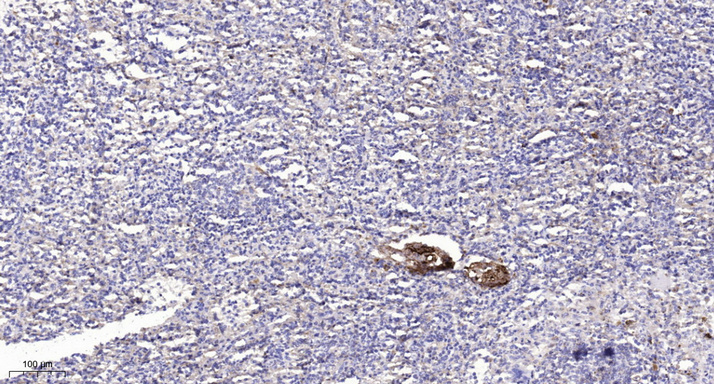Karyopherin α2 (Acetyl Lys22) rabbit pAb
- 货号:YK0153
- 应用:WB;ELISA;IHC
- 种属:Human;Mouse;Rat
- 靶点:
- Karyopherin α2
- 简介:
- >>Nucleocytoplasmic transport;>>Influenza A;>>Chemical carcinogenesis - receptor activation
- 基因名称:
- KPNA2 RCH1 SRP1
- 蛋白名称:
- Karyopherin α2 (Acetyl Lys22)
- Human Gene Id:
- 3838
- Human Swiss Prot No:
- P52292
- Mouse Gene Id:
- 16647
- Mouse Swiss Prot No:
- P52293
- 免疫原:
- Synthesized peptide derived from human Karyopherin α2 (Acetyl Lys22)
- 特异性:
- This antibody detects endogenous levels of Human,Mouse,Rat Karyopherin α2 (Acetyl Lys22)
- 组成:
- Liquid in PBS containing 50% glycerol, 0.5% BSA and 0.02% sodium azide.
- 来源:
- Polyclonal, Rabbit,IgG
- 稀释:
- WB 1:500-2000;IHC 1:50-300; ELISA 2000-20000
- 纯化工艺:
- The antibody was affinity-purified from rabbit serum by affinity-chromatography using specific immunogen.
- 浓度:
- 1 mg/ml
- 储存:
- -15°C to -25°C/1 year(Do not lower than -25°C)
- 其他名称:
- Importin subunit alpha-2 (Karyopherin subunit alpha-2;RAG cohort protein 1;SRP1-alpha)
- 实测条带:
- 60kD
- 背景:
- The import of proteins into the nucleus is a process that involves at least 2 steps. The first is an energy-independent docking of the protein to the nuclear envelope and the second is an energy-dependent translocation through the nuclear pore complex. Imported proteins require a nuclear localization sequence (NLS) which generally consists of a short region of basic amino acids or 2 such regions spaced about 10 amino acids apart. Proteins involved in the first step of nuclear import have been identified in different systems. These include the Xenopus protein importin and its yeast homolog, SRP1 (a suppressor of certain temperature-sensitive mutations of RNA polymerase I in Saccharomyces cerevisiae), which bind to the NLS. KPNA2 protein interacts with the NLSs of DNA helicase Q1 and SV40 T antigen and may be involved in the nuclear transport of proteins. KPNA2 also may play a role in V(D)J re
- 功能:
- domain:Consists of an N-terminal hydrophilic region, a hydrophobic central region composed of 10 repeats, and a short hydrophilic C-terminus. The N-terminal hydrophilic region contains the importin beta binding domain (IBB domain), which is sufficient for binding importin beta and essential for nuclear protein import.,domain:The IBB domain is thought to act as an intrasteric autoregulatory sequence by interacting with the internal autoinhibitory NLS. Binding of KPNB1 probably overlaps the internal NLS and contributes to a high affinity for cytoplasmic NLS-containing cargo substrates. After dissociation of the importin/substrate complex in the nucleus the internal autohibitory NLS contributes to a low affinity for nuclear NLS-containing proteins.,domain:The major and minor NLS binding sites are mainly involved in recognition of simple or bipartite NLS motifs. Structurally located within i
- 细胞定位:
- Cytoplasm . Nucleus .; Endoplasmic reticulum membrane. Golgi apparatus membrane . (Microbial infection) Retained in ER/Golgi membranes upon interaction with SARS-COV virus ORF6 protein. .
- 组织表达:
- Expressed ubiquitously.
- June 19-2018
- WESTERN IMMUNOBLOTTING PROTOCOL
- June 19-2018
- IMMUNOHISTOCHEMISTRY-PARAFFIN PROTOCOL
- June 19-2018
- IMMUNOFLUORESCENCE PROTOCOL
- September 08-2020
- FLOW-CYTOMEYRT-PROTOCOL
- May 20-2022
- Cell-Based ELISA│解您多样本WB检测之困扰
- July 13-2018
- CELL-BASED-ELISA-PROTOCOL-FOR-ACETYL-PROTEIN
- July 13-2018
- CELL-BASED-ELISA-PROTOCOL-FOR-PHOSPHO-PROTEIN
- July 13-2018
- Antibody-FAQs
- 产品图片

- Immunohistochemical analysis of paraffin-embedded human spleen. 1, Antibody was diluted at 1:200(4° overnight). 2, Tris-EDTA,pH9.0 was used for antigen retrieval. 3,Secondary antibody was diluted at 1:200(room temperature, 45min).


